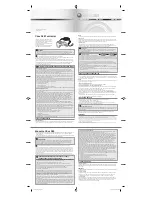
42
L
ø
A
L
Body mounting reference plane
To prevent the workpiece fixing bolts from touching the body, use bolts
that are 0.5 mm or shorter than the maximum screw-in depth. If long
bolts are used, they can touch the body and cause a malfunction, etc.
Workpiece fixed
Body fixed
Handling
Maintenance
Caution
10. When mounting the product, use screws with
adequate length and tighten them with adequate
torque.
Tightening the screws with a higher torque than
recommended may cause a malfunction, whilst the tightening
with a lower torque can cause the displacement of the
mounting position or in extreme conditions the actuator could
become detached from its mounting position.
11. Do not operate by fixing the table and moving the
actuator body.
12. The belt drive actuator cannot be used vertically
for applications.
13. Vibration may occur during operation, this could
be caused by the operating conditions.
If it occurs, adjust response value of auto tuning
of driver to be lower.
During the first auto tuning noise may occur, the
noise will stop when the tuning is complete.
14. When mounting the actuator using the body
mounting reference plane, use a pin. Set the
height of the pin to be 5 mm or more because of
chamfering. (Recommended height 6 mm)
Maintenance frequency
Perform maintenance according to the table below.
•
Items for visual appearance check
1. Loose set screws, Abnormal dirt
2. Check of flaw and cable joint
3. Vibration, Noise
•
Items for internal check
1. Lubricant condition on moving parts.
∗
For lubrication, use lithium grease No. 2.
2. Loose or mechanical play in fixed parts or fixing screws.
•
Items for belt check
Stop operation immediately and replace the belt when belt
appear to be below. Further, ensure your operating
environment and conditions satisfy the requirements specified
for the product.
a. Tooth shape canvas is worn out.
Canvas fiber becomes fuzzy. Rubber is removed and the
fiber becomes whitish. Lines of fibers become unclear.
b. Peeling off or wearing of the side of the belt
Belt corner becomes round and frayed thread sticks out.
c. Belt partially cut
Belt is partially cut. Foreign matter caught in teeth other than
cut part causes flaw.
d. Vertical line of belt teeth
Flaw which is made when the belt runs on the flange.
e. Rubber back of the belt is softened and sticky.
f . Crack on the back of the belt
∗
Select whichever comes sooner.
Warning
Series
LEJ
Electric Actuator/
Specific Product Precautions 2
Be sure to read before handling. Refer to back cover for Safety Instructions.
For Electric Actuator Precautions, refer to “Handling Precautions for SMC Products”
and the Operation Manual on SMC website, http://www.smcworld.com
Frequency
Appearance check Internal check
Belt check
Inspection before
daily operation
—
—
Inspection every
6 months/1000 km/
5 million cycles
∗
Model
Bolt
Max. tightening
torque (N
⋅
m)
ø
A
(mm)
L
(mm)
LEJ
40
M5
3.0
5.5
36.5
LEJ
63
M6
5.2
6.8
49.5
Model
Bolt
Max. tightening
torque (N
⋅
m)
L
(Max. screw-in
depth) (mm)
LEJ
40
M6 x 1
5.2
10
LEJ
63
M8 x 1.25
12.5
12
A
















































